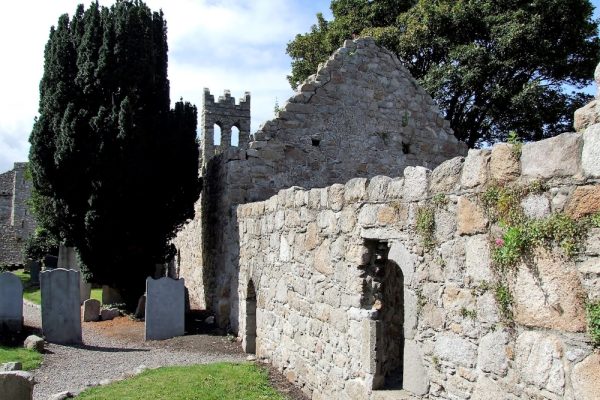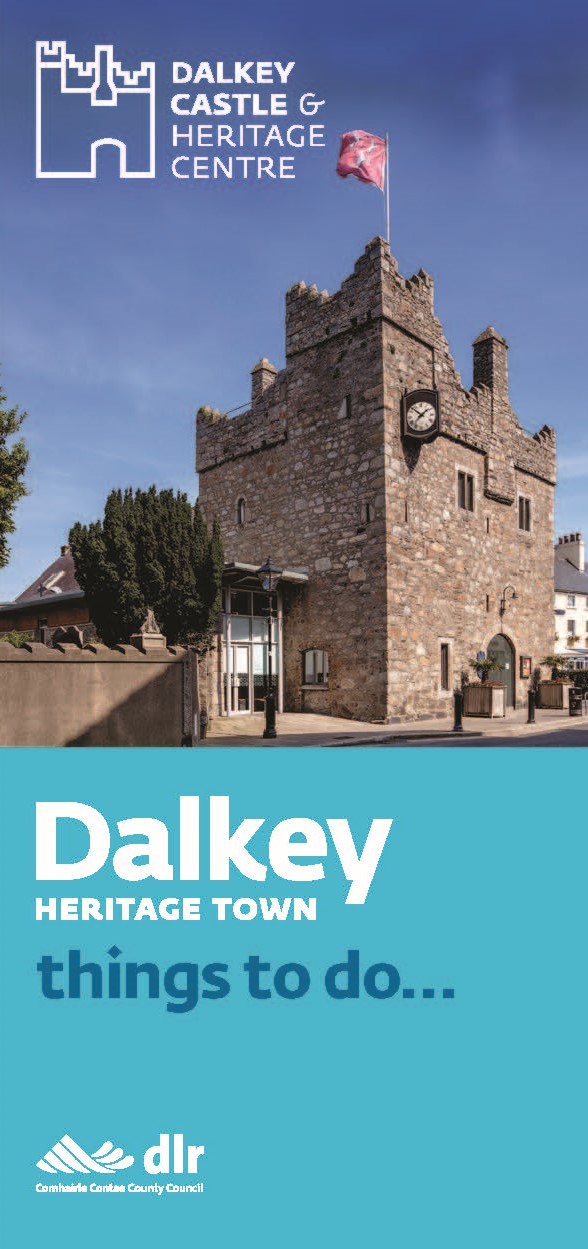Now well known for its stunning scenic surroundings on ‘Ireland’s Amalfi Coast’, the town of Dalkey near Dublin City Centre, Ireland, has an ancient, rich and varied history. It rose to prominence through great surges of activity and rested as a sleepy fishing village in the intervening times.
The name Dalkey comes from the Old Irish Name for Dalkey Island, ‘Deilg Inis’ which means ‘Thorn Island’. This was later changed to Deilg–ei by the Vikings, Dalk-ei by the Normans and later anglicised to Dalkey.
Some artefacts date inhabitation of Dalkey Island to over 6,000 years ago (4,500 B.C.), older than Stonehenge and the Great Pyramids of Giza. A skull, filled with periwinkle shells, was found during an excavation in the 1960’s which was dated to 2,500 B.C. The earliest written record of Dalkey is from the ‘Annals of the Four Masters‘ which refer to a time in 1699 B.C. when Heremon and Heber assumed joint sovereignty of Ireland and Dun Deilginis (the fort of thorn island) was built.
In the 5th and 6th centuries, the most northern point of Dalkey Island was indeed the home of a strategic fort. In archaeological digs of the ruins, bronze pins, glassware and wine jugs from all over the world were found. Some were imported from as far away as Greece, North Africa and the Dalmatian coast, suggesting Dalkey was always a busy trading port.
Dalkey initially grew as a small village around the Early Christian Church of the virgin saint, St Begnet around the 7th Century, a resting point as pilgrims made their way to the monastic site at Glendalough. A holy well and church ruins associated with St. Begnet can be found on Dalkey Island, along with two other holy wells on the mainland. Here at Dalkey Castle & Heritage Centre, our 10th Century granite Church ruins are thought to have replaced an earlier 7th Century wooden church on the site.
The Vikings arrived in longboats to Dublin in 795 AD and settled from 841 AD onwards. During their reign Dublin became the most important town in Ireland as well as a hub for the western Viking expansion and trade. It is in fact, one of the best known Viking settlements.
Dalkey’s prominence in the world markets continued throughout the time thanks to boats struggling to anchor in the shallow waters of the River Liffey in Dublin. Dalkey was the easier port and trade thrived. During this time, Dalkey Island also had a dark history as the holding place for Viking slaves and prisoners. A hoard of Viking coins found in Victorian times in Castle Street, Dalkey have the head of King Edgar who ruled from 959-975 A.D. They are now in the British Museum.
With the defeat of the Vikings at the Battle of Clontarf in 1014, Dalkey was a sleepy village again comprising some cabins, a few inns, burgages and gardens. It awoke once more with the Norman invasion of Ireland which took place during the late 12th century.
This growth in trade was again influenced by the anchorage provided for large Norman ships in Dalkey Sound. From the mid-1300s to the late 1500s, large Norman ships could not access Dublin, as the river Liffey was silted up. They could however anchor safely in the deep waters of Dalkey Sound.
In 1358, the Dublin Merchants succeeded in an application to the Crown to use the deep and sheltered waters of Dalkey Sound to off- load goods bound for Dublin. The ships were lightened and the goods were either brought by road to store houses in Dalkey or went by shell boat into Ringsend.
With all that trade, the town was often subject to marauding attack by the riotous O’Byrne and O’Toole clans from deep within Wicklow, so in 1390, Seven defensive Medieval Castles were built in Dalkey by the merchants to protect the goods before transportation to Dublin.
Eventually, Dalkey acquired the dubious renown of being a hub for smuggling, a town of Pillaging Pirates! In fact, things got so serious that a water bailiff was commissioned for the area to ensure that only the right cargo was being removed from the ships and that the right taxes were paid. Local schoolgirls claim an underground tunnel exists between Dalkey Island and mainland Dalkey, although these days it would be blocked up to prevent wayward explorers from getting hurt from a cave in!
In 1482, Dalkey was granted a licence to hold a weekly market on Tuesdays, possibly to regularise an existing market. There was an Annual Fair on the feast of St Begnet on 12th November. The shopkeepers in the town had to close their shops and set up stalls outside the town and pay a tax to the Archbishop of Dublin who used this money for the upkeep of the walls and pathways. This was referred to as murage and pavage.
As Dublin port was dredged and developed, through the later 1500 and 1600s, the town of Dalkey became unimportant to the merchants who had so needed it and the town slipped into decline. By 1630, St Begnet’s Church here was reported to be abandoned and roofless. Dalkey reverted to a sleepy fishing village.
During the Napoleonic Wars, 26 Martello towers were built along the coastline for defence against a possible French invasion. One of these towers can be seen on Dalkey Island, the other one nearby is in Sandycove, and now houses the James Joyce Museum. We run Bloomsday Events, Guided Literary Walks and Luxury Experiences related to James Joyce at Dalkey Castle.
November 19th 1807 was a tragic day in the area’s history. Several ships left Dublin carrying troops bound for the Napoleonic Wars. The next day, two ships, The Rochdale and the HMS Prince of Wales, having been caught in gale force winds and heavy snow, were lost. The bodies were washed up for weeks afterwards along the shore. A number are buried here in St Begnet’s Graveyard. The loss of almost all of the four hundred lives on board was a catalyst for the building of the Dun Laoghaire harbour, which began in 1817.
This led to Dalkey’s next rise to prominence with the excavation of granite in Dalkey Quarry around that time. The coming of a new invention, the Dalkey Atmospheric railway in 1844, and a successful quarry which had provided the stone for Kingstown (now Dun Laoghaire) pier, meant good fortune for the people of Dalkey. The railway used part of the quarry industrial tramway (see if you can spot the old tramyard in town). The arrival of the railway also meant that people could now work in Dublin City but live in larger homes out on the coast and take in the clean sea air and stunning scenic views.
The Dalkey Gold Rush began in 1833 when Miss Etty Scott, a miner’s daughter, dreamt that a horde of Viking gold was buried under Dalkey Hill towards Coliemore Harbour. According to Gaskin’s Irish Varieties of 1869, Etty told her family and friends, “Wait with patience…for the secreted treasure of the Dane will be surely found if you hearken to my voice”.
The miners living on the Commons of Dalkey all rushed to stake claims and this led to the establishment of a Dalkey Goldmining Society. It all ended in tears when some prankster Trinity College medical students left a bag of fluorescently painted cats to be discovered and no gold was found.
There was a happy ending for the Dalkey miners however. A case around the same time involving squatters on Ballymore Eustace held that they were entitled to ownership of the land occupied by them for the past twenty or so years. They sold their plots (on which most of the big houses of Dalkey were subsequently built) to building speculators for substantial sums of money. Sadly, the fair Etty (described by ballad singers of the day as ‘Dalkey’s beautiful dreamer’) failed to benefit from the sale of her father’s plot. She died of consumption, or possibly embarrassment, not long after the failure of her gold mining enterprise.
During the 18th and early 19th century, the wealthy residents of Dalkey would go on a Grand Tour of Europe. When they reached the Bay of Naples, they noted a similarity between its stunning scenery and the stunning scenery surrounding us here in Dalkey. This inspired them to give their Dalkey villas Italianate place-names such as Amalfi and Sorrento when they returned from their travels, hence Dalkey’s tagline today of ‘Ireland’s Amalfi Coast’.
Dalkey Castle, Dublin, Ireland is a 14th Century Medieval Castle & an Irish Recorded National Monument & Landmark.
It is a Rare Medieval Townhouse Castle given that it is the only remaining one of seven, open to the public. These Fortified Castles were built in 1390, in Dalkey, by Medieval merchants looking to protect their goods, before transportation to Dublin City Centre.
The other 6 Castles were Dungans, Yellow Castle, Wolverton’s, House Castle, Black Castle and Archbold’s Castle (a portion of which also remains in town today). Ground plaques along Dalkey’s streets indicate the original sites of all the Castles. See if you can find them all or let us show you on one of our guided walks.
The Medieval Castles have some excellent defensive features to protect the goods from being plundered. These are all still visible in Dalkey Castle; the Machicolation, the Murder Hole, the Battlements with its Warders’ Walk, and slit arrow-loop windows. You will also see a fine example of barrel-vaulted ceiling and traces of the wicker work that supported it. Many niches have been exposed on the walls where precious goods may have been stored. We have a replica of the Stocks which these days acts as your selfie point!
Back in the 1600s, Dalkey Castle was known as Goat Castle. Contrary to some myths this was not after the goats on Dalkey Island, but rather a mispronunciation, as it was named for the Cheevers family who owned the Castle in the 1600s; ‘Chevre’ being the french word for goat. You can see the ground plaque for Goat Castle outside the door and the flag with goat motif flying high above the Castle when you come to visit.
Dalkey Town Hall
In the early 1890s, Dalkey Town Hall was built onto Goat Castle to host community events. The ground floor of the Castle became the Foyer to the new Town Hall. The upstairs room of the Castle was used as a meeting room for the Dalkey Town Commissioners.
The building has hosted ‘dramatic’ events since the early 1900s. Eamon De Valera addressed a rally here in the 1930s. Hugh Leonard frequently referred to it in his memoir ‘Home Before Night’ and, in his play ‘A Life’, the young Desmond delivers a speech in the Town Hall.
Over the years the space has been a dance hall, a voting venue, a library, a temporary Church, a sports arena & a theatre. The hall continues to be a valuable community space with dance & exercise classes and community plays. The All-Ireland award winning drama group, Dalkey Players stage their productions here.
The complex is a very popular cultural attraction & venue which hosts a multitude of events including Writers’ festivals, exhibitions, product launches, brand activation events, award ceremonies, small & large-scale filming location, client & staff entertainment, team building, networking and corporate events.
A unique venue, steeped in history and in an atmospheric location, it is perfect for your next event! To book one of our luxury experiences for your staff, client or corporate group or to discuss venue hire, submit an email and a member of the team will liaise with you.
St Begnet’s Church & Graveyard
The atmospheric 10th Century granite Church named after the virgin Saint, St. Begnet, probably replaced an earlier wooden church dating back to the 7th Century Early Christian period.
A Church and Holy Well to St. Begnet can be found on Dalkey Island alongside two other holy wells on the mainland.
Much of the story of St. Begnet is lost in the mists of history. Her name is recorded in the genealogies of Irish saints as Becnat, daughter of Colman, from an aristocratic family of Dal Messin Corb. This family ruled Leinster, but in 700AD lost their power and were confined mainly to the Wicklow mountains. St. Kevin of Glendalough was also thought to be from the same family line. Kilbegnet (Church of St. Begnet in Irish) was considered to be a pilgrimage stop on the way to the great monastic settlement at Glendalough so this would make sense.
St. Begnet supposedly fled to Britain to escape an arranged marriage where she converted and returned to Ireland as a missionary. She founded her churches and baptized new converts in the well on the Island. Today the well is associated with the curing of scurvy, which seems appropriate being the point of the passage of so many sailors and merchants down through the years.
St. Begnet is now the patron saint of Dalkey and her feast day is on the 12th November, as recorded in the medieval Book of Obits of Christ Church Cathedral, Dublin.
Stop in to the Church of the Assumption opposite Dalkey Castle to see an icon of St. Begnet in which she sports a fancy gold bangle which legend has it was given to her by an angel on her conversion. A bangle was said to have been preserved for some time as a relic of Saint Begnet in Saint Bee’s convent in Britain.
The Nave of the Church here at Dalkey Castle dates to the 10th Century. The Bellcote, Chancel & Chancel Arch were added in the 13th Century. The belfry has twin bells which were struck by hand. The East window of the Chancel was added during the 16th century. Besides the low doorways there are a number of other interesting features to look out for in the church. Inside the Nave on the eastern side of the doorway is a Stoup and there is an Ambry built into the southern wall of the chancel. Of particular note, on the northern side of the church is a rare Tau Cross.
The area around the church was thought to have been used as a burial ground from the 13th Century but the early graves are not marked.
Dalkey Castle does have one of the best examples of a Viking gravestone known as a Rathdown slab. You can find others built into the walls at St. Patrick’s Cathedral in Dublin. This particular slab is one of the finest examples and, standing at about 5 ft tall, one of the largest. It is thought the slab may have been decorated originally with Viking art such as cup marks, but that a number of christian symbols such as the large ring with a cross in the centre, may have been added later.
The slab, dating back to around the 10th Century, was discovered in the graveyard accidentally in 1826 when ‘Red Bill’ Harwood, an old seaman, pointed out the place where he wished to be buried. A short while later, when he passed away, workmen digging his grave unearthed the Dalkey Rathdown Slab.
Scattered throughout the graveyard are a number of decorated headstones. The earliest named gravestone is of someone called Cornelius in 1738. “King of Dalkey”, Hugh Dempsey, is buried on the south side of the church. A number of bodies from the ship wrecks of troops bound for the Napoleonic Wars in 1807 are also buried here. The most recent headstone is Kavanagh in 1930. The graveyard is now closed as a place of burial. Burial records from 1901 – 1911 have been digitised and can be found online at: https://repository.dri.ie/catalog/pc28qk881#dri_download_modal_id
Names of those buried from the 1700s to 1900s can be found on a Map in the Heritage Centre.
The “King of Dalkey”, a mock elective monarchy associated with Dalkey Island, is a local tradition which dates to at least 1787, although some accounts suggest Hugh Dempsey had been crowned as far back as 1780. “King” Dempsey is buried on the south side of St.Begnet’s church here at Dalkey Castle.
“King of Dalkey” started when a group of freemen of Dalkey formed a club into which they brought wits, poets and thinkers. They summoned a “Pimlico Parliament”, named after the Pimlico Liberty of Dublin, and “hurled broadsides” at the perceived pomposity of Dublin Castle.
Seen as a good reason for a bit of a party, several thousand people reputedly attended the regal procession and carnival in August 1787 as Stephen Armitage (pawnbroker and printer) became “King Stephen the First, King of Dalkey”. The bombastic full title given was “His Facetious Majesty, King of Dalkey, Emperor of the Muglins, Prince of the Holy Island of Magee, Elector of Lambay and Ireland’s Eye, Defender of his own Faith and Respecter of All Others, Sovereign of the Illustrious Order of the Lobster and Periwinkle”. The coronation ceremony was held, with “mock gravity and ceremony”, in St. Begnet’s Church on Dalkey Island.
Although the tradition of electing a mock “King of Dalkey” was interrupted around the time of the 1798 Rebellion, it has been revived occasionally over the years, firstly in 1850, then in 1934 as a British Pathe clip illustrates, in 1965 and again in 1983 when King Larry the First was enthroned. As of 2014, the title is bestowed on the local sacristan, Finbarr Madden.
These days a vibrant Lobster festival is held annually in August to showcase the area’s local seafood with visitors from around the globe in attendance. You can see video footage of the crowning of the ‘King of Dalkey’ in the Heritage Centre.
Dalkey Castle Heritage Centre & Modern Dalkey
Findlater’s, the first grocery store, opened in 1897. The Carnegie Library opened in 1902. James Joyce taught in the Clifton School in 1904. Dalkey became a heritage town in 1995. The Heritage Centre was opened in 1998 and it has won numerous awards at national level.
The Heritage Centre offers a deeper dive into the history of the area, with scaled models, interactive touchscreens presenting information in twelve languages, and a timeline from the earliest settlers on the island, through Early Christian, Viking, Medieval and Victorian times to the present day.
Delve deeper into Dalkey’s history. There is a wealth of interesting historical, and sometimes anecdotal, information. Switch between the engineer’s drawings of Dalkey Town Hall and the newspaper cuttings of the Dalkey Gold Rush to the Pathé news footage of the crowning of the ‘King of Dalkey’.
The Heritage Centre also has an impressive Writers’ Gallery featuring 45 renowned Irish writers and creative artists from James Joyce to Bono, Hugh Leonard, Flann O’Brien, G.B. Shaw, Samuel Beckett and Maeve Binchy, all of whom have associations with Dalkey.
To find out more about these writers, you can join a Guided Literary Walk that tours local landmarks and shares anecdotes about the writers and the characters they created.
Modern Dalkey is a vibrant town with a village vibe. It is famously home to a host of celebrities including U2’s Bono and The Edge, Neil Jordan, Van Morrison, Pat Kenny, Ryan Tubridy and Enya.
As a celebrity haunt it has welcomed numerous stars from George Clooney, Sean Penn, Brad Pitt, Julia Roberts, Tara Reid, Olivia Wilde, Pierce Brosnan, Frances McDormand, Russell Crowe, Jane Seymour, Niall Horan, Lewis Capaldi, Harry Styles, Lindsay Lohan & Matt Damon hence its other tagline of the ‘Hollywood Hills of Ireland’. The local community prides itself on maintaining a level of respect and privacy for visitors. It is a much sought-after place to live.
Matt Damon said of it: “This is one of the most beautiful places we’ve ever been….It’s absolutely gorgeous…Even in the 2km lockdown, we’ve got trees and forest and woods and ocean. I can’t think of any place you’d rather be in a 2km radius of…It’s a little like a fairytale”.
The local community are proud of their rich ancestral heritage and welcome all visitors to share the ancient history of their home town.
Dalkey has a wealth of boutique shops, cafes, pubs and restaurants and is a charming place to spend a day. There are a multitude of local attractions to visit as part of a day tour from Dublin.
Dalkey wins many awards in the National Tidy Towns competitions. Dalkey’s Tidy Towns community uncovered, preserved & maintain the Éire 7 navigation marker from WW2 which can be seen on the coastline.
The town also hosts a number of festivals throughout the year.
Dalkey Comedy Festival kicks off proceedings around St.Brigid’s Day (Imbolc) at the beginning of February. Then we have St. Patrick’s Day in March, followed by Easter. Dalkey Vintage & Classic Car Festival runs at the beginning of June. Then we have Bloomsday celebrating all things James Joyce on the 16th June. Dalkey Castle runs Joycean events and experiences surrounded by the beautiful colour of the occasion.
Dalkey Book Festival runs in tandem with this in mid June each Year. It has been referred to as “The best little festival in the world….The scale of the town is small but the size of the ideas are gigantic”. Festival contributors have included Salman Rushdie, David McWilliams, Seamus Heaney, Edna O’Brien, Roddy Doyle, Maeve Binchy, Joseph O’Connor, Jennifer Johnston, Robert Fisk, Dawn O’Porter, Sally Rooney, Donal Ryan & Bono.
Coastival runs in July showcasing the south Dublin coastal community’s connections with the water. Colourful kites, watersports & family fun can be accessed along the coastline.
Irish National Heritage Week is in August and as a heritage town with an ancient, rich, heritage, we host a number of Heritage Week events. The town also hosts the Dalkey Lobster Festival in late August, which showcases local seafood and global musicians.
Echoes Festival, a Literary Festival with well known contemporary writers where Maeve Binchy’s writing & social commentary provides the inspiration for contemporary discussion & performances is held in October.
Dalkey Castle also holds seasonal events for Halloween & Christmas.
Meet the Team
A dedicated team of Tour Guides, Volunteers and Actors from Deilg Inis Theatre Company* ensure the successful running of the Living History Tour, Guided Walks and other Events & Experiences at Dalkey Castle & Heritage Centre.
Community Employment (CE) and TUS provide personnel who are trained professionally in-house as tour guides, supported by Department of Social Protection.
Dalkey Irish Heritage Town Company is the not for profit parent company of Dalkey Castle & Heritage Centre. Our charitable purposes are supporting Dalkey as one of the officially designated heritage towns of Ireland, & the promotion, celebration and advancement of the arts, culture, education & heritage of Ireland for the benefit of the community and the public good.
The Board Approved Strategy for 2025 – 2029 is available to view here
Dalkey Irish Heritage Town Company is governed by a voluntary Board of Charity Trustees. We are committed to best practice governance and are compliant with the Charities Regulator’s Charities Governance Code. We comply with all regulatory requirements and operate in accordance with our governing document. We keep records of accounts and maintain strict financial controls. The organisation is transparent in its audited financial statements. Annual reports, financial statements & policies in compliance with the Charity Governance Compliance Code available on request.
*Deilg Inis Theatre Company is funded by the Community Services programme and managed by Pobal.
 Dalkey Irish Heritage Town Company is a not for profit independent charitable trust, RCN 20026363, CHY no. 10342.
Dalkey Irish Heritage Town Company is a not for profit independent charitable trust, RCN 20026363, CHY no. 10342.

Margaret Dunne
Manager & Festival Director of ECHOES

Elizabeth Crossen
Reception & Training Supervisor

Maeve Kingston
Administrator
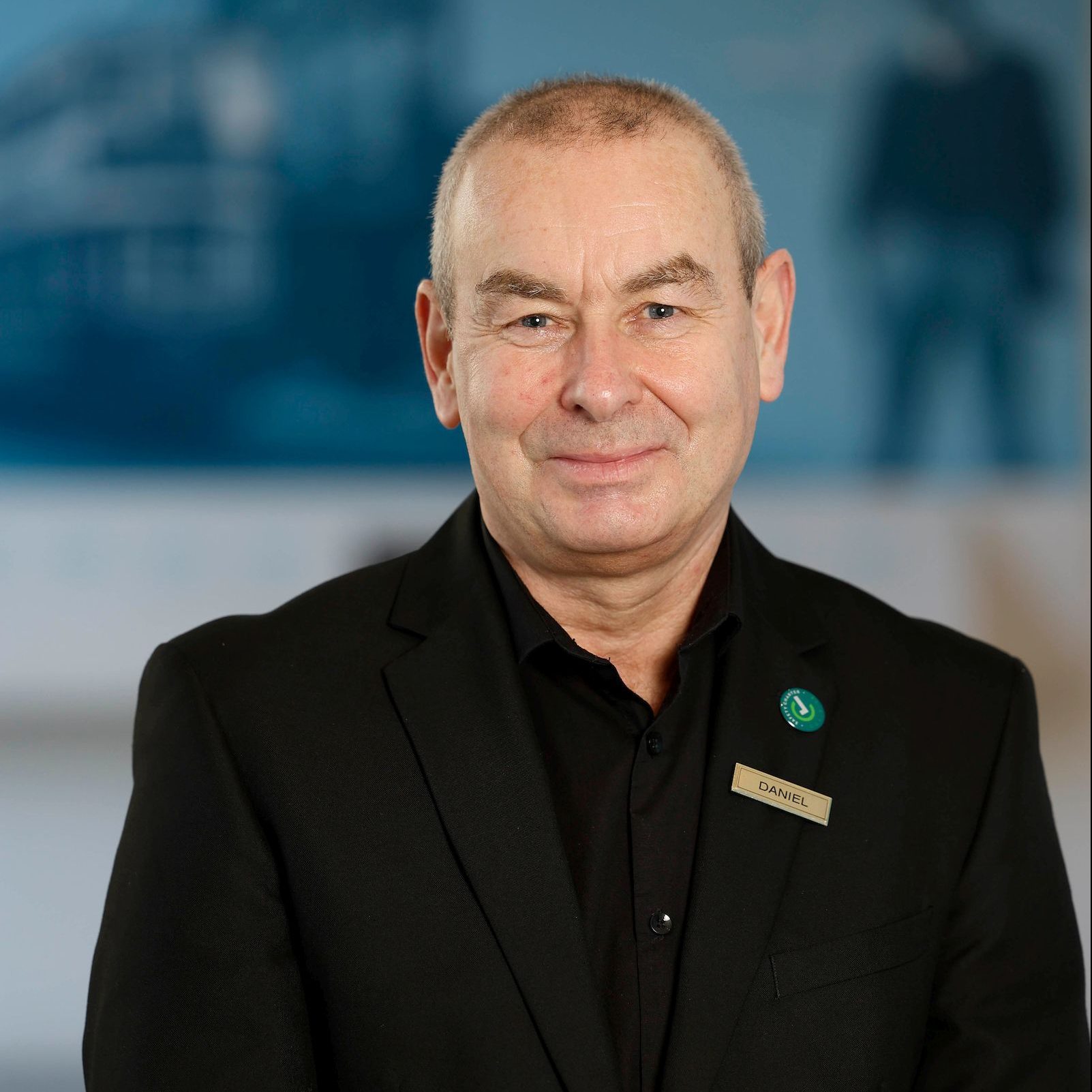
Daniel O’Brien
Caretaker
The Team from Dalkey Castle on a Research Trip to Dalkey Island
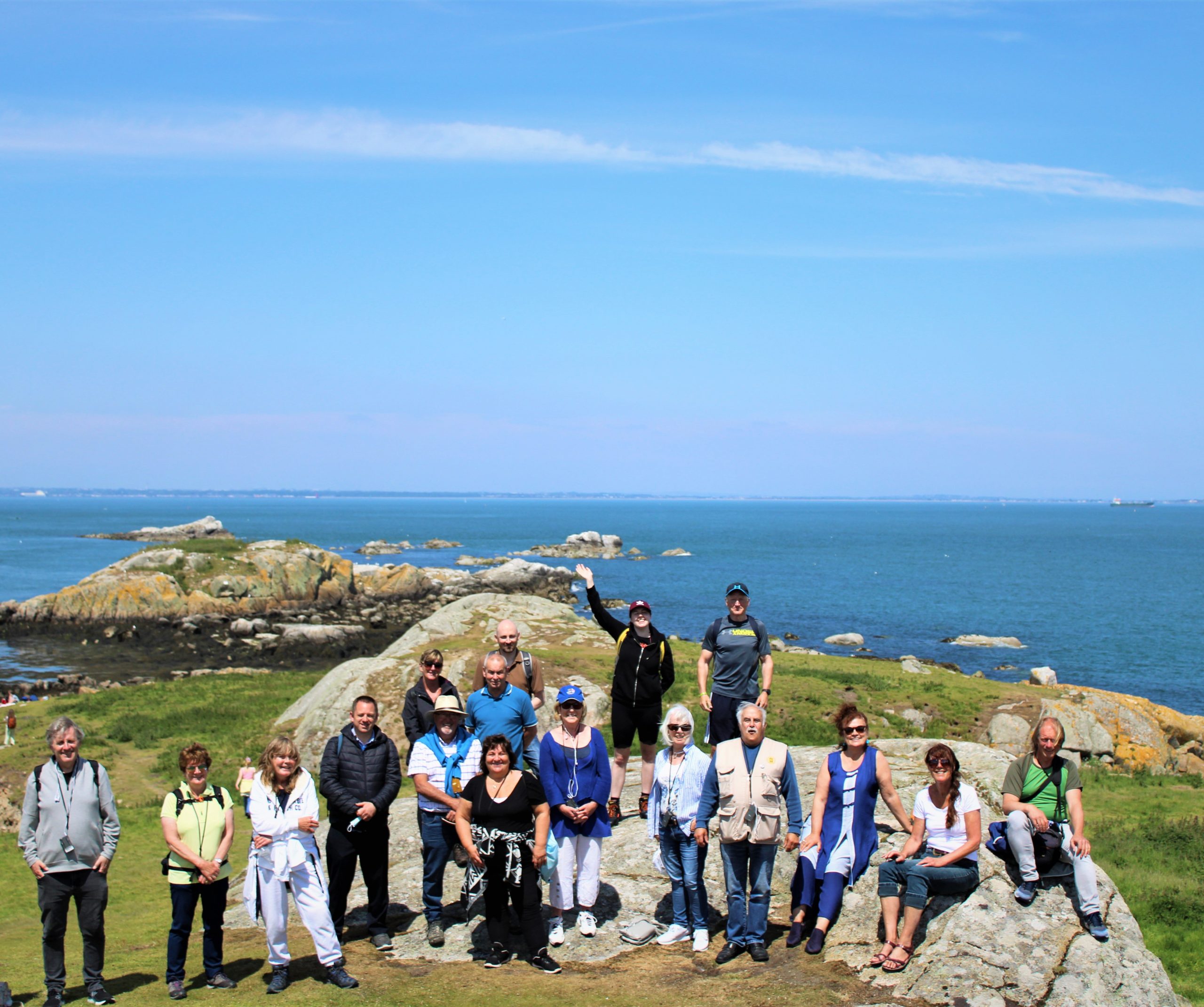
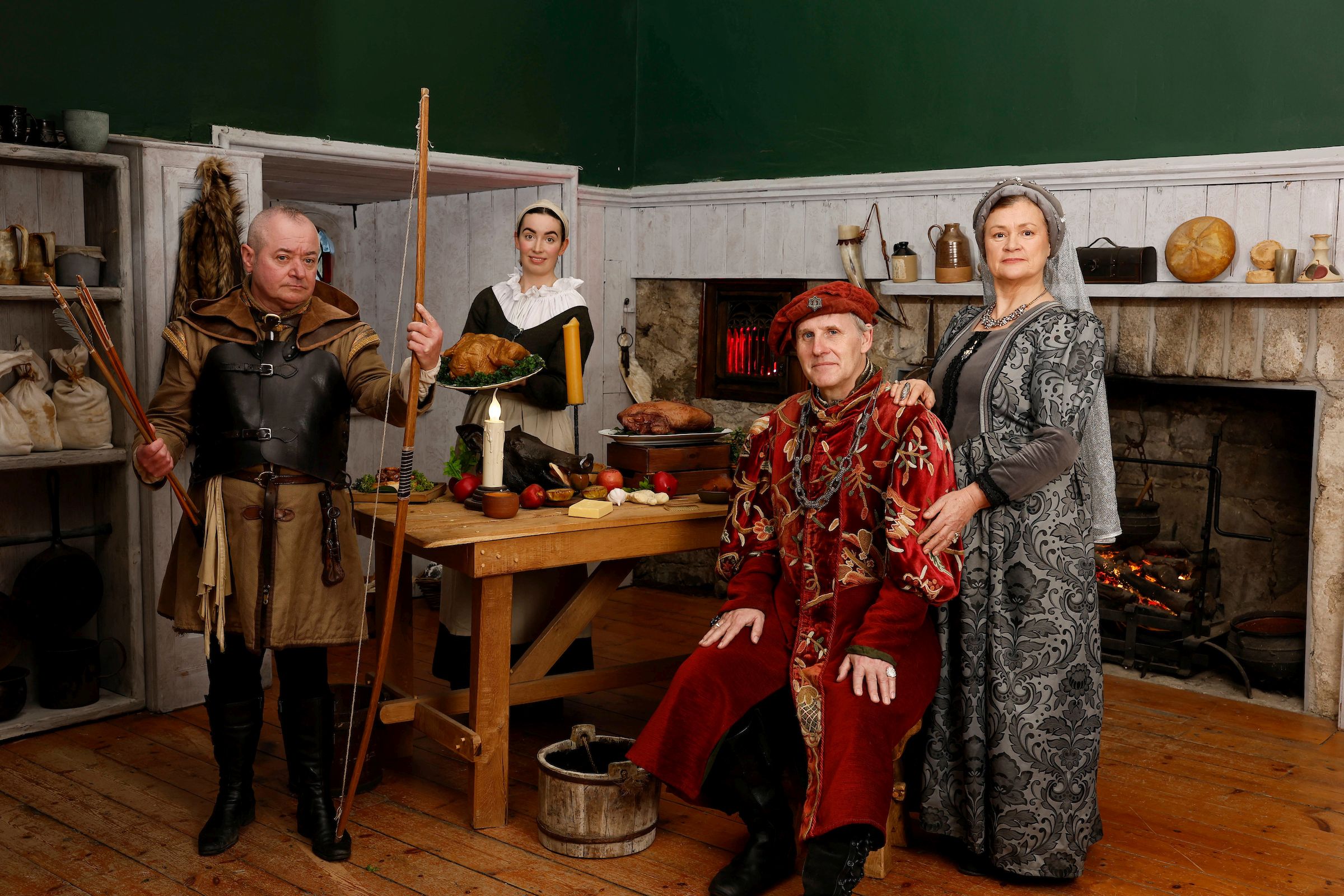
living history theatre company
Deilg Inis
Supported by Community Services Programme of Pobal, Deilg Inis Theatre Company are the only full-time professional theatre company devoted to helping people tell their unique stories – in terms of physical place, social history, and literary heritage. They specialise in site-specific drama that brings history to life and life to history make it live and breathe through costumed, professional actors.
Founded in 2003, the Deilg Inis actors provide a live theatre performance as part of every Living History tour at Dalkey Castle.
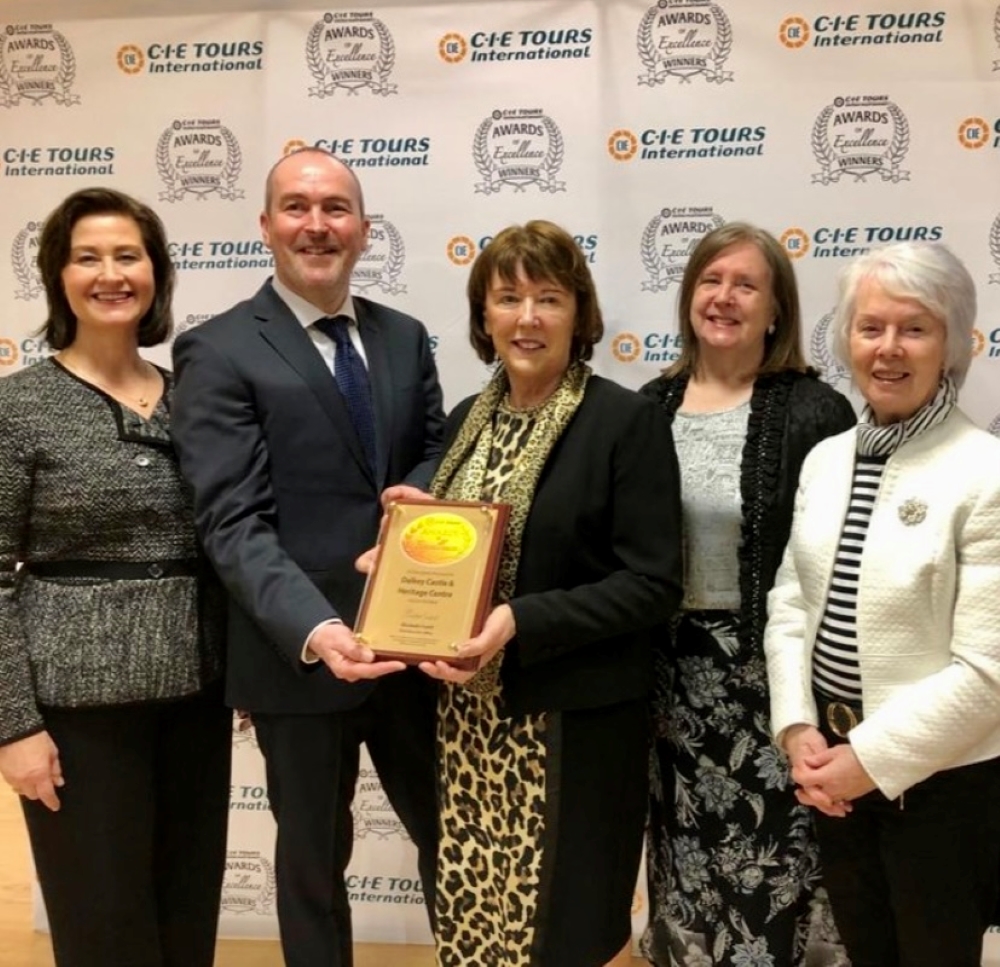
Awards & Accreditations
Dalkey Castle won the Overall National Heritage Award in 2016, the Failte Ireland Excellence in Customer Care Award 2018 and CIE Award of Excellence & TripAdvisor Certificates of Excellence in 2013, 2014, 2015, 2016, 2017, 2018, 2019, 2023, 2024 and 2025 from customer satisfaction surveys. Tours consistently receive glowing 5-star reviews from our visitors.
What our Visitors say...

Directions & Transport
Dalkey is on some of the most stunning coastline, with a mountainous backdrop, just south of Dublin City Centre, en route to Co. Wicklow.
Aside from by car, the quickest way to reach the Castle is by DART. The DART journey is a relaxing experience travelling along the beautiful coastline with magnificent sea views. Dalkey is approx. 30 minutes from Dublin's Connolly, Tara or Pearse stations (travelling south). Turn right on exiting Dalkey train station.
Dalkey is on the Aircoach route to/from Dublin Airport. From Dublin City Centre, a number of local bus options are also available. Paid parking and coach parking are available nearby.
Dalkey Castle postcode for Google Maps is A96 DE61.

Opening Times
We are open six days a week, all year round.
Closed every Tuesday.
January - May & September - December
Monday to Friday: 10.00 - 17.30
Saturday, Sunday & Public Holidays: 11.00 - 17.30
June, July & August
Monday to Friday: 10.00 - 18.00
Saturday, Sunday & Public Holidays: 11.00 - 18.00
Tickets & Info
Tickets for Living History Tour encompass fully guided tour of 14th Century Townhouse Castle, 10th Century Early Christian Church & Graveyard, Modern Writers' Gallery & Heritage Centre with interactive screens & scale models. Dalkey Castle, where costumed actors bring history to life.
ADULTS €16
SENIOR / STUDENT €15
CHILD (4-12 YEARS) €10.50
*Booking Fees apply







